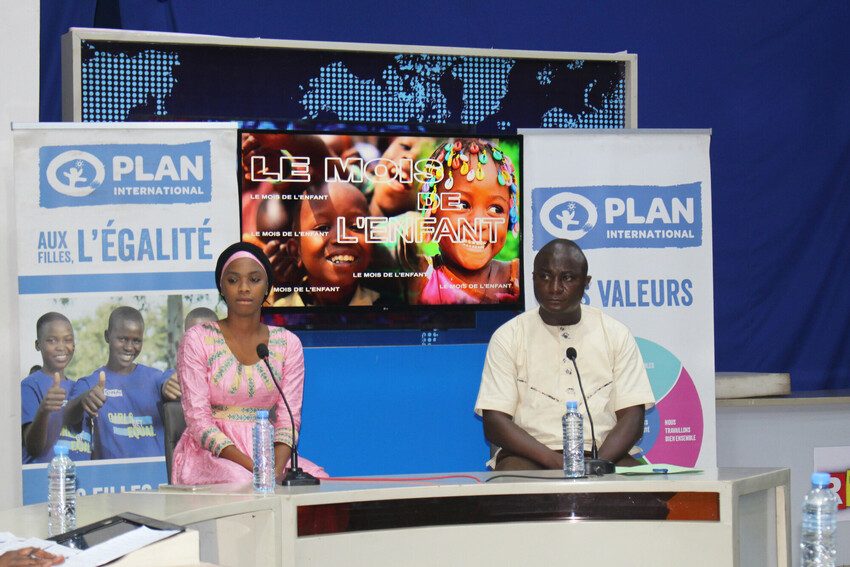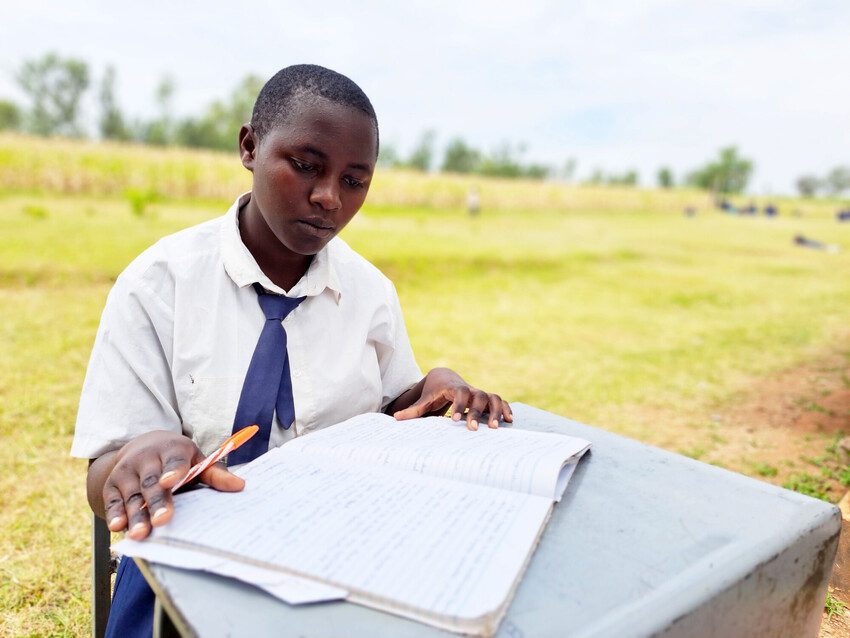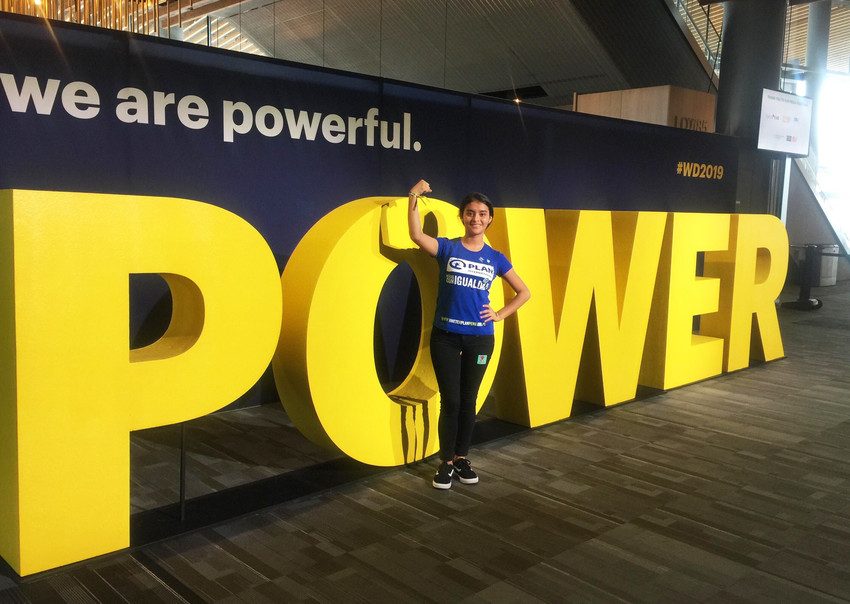Gender-based violence
Gender-based violence (GBV) is a violation of human rights. We're working to transform attitudes towards girls and women that perpetuate violence against them.
Génesis, 12, from Honduras (pictured) teaches girls how to stay safe from harm. Image credit: Plan International / World Art Media / Vicente Sevilla.
Gender-based violence (GBV) refers to any act of violence that is directed against an individual based on their gender identity or perceived gender. It is a widespread and persistent problem that affects people of all ages, cultures, and backgrounds.
GBV includes: violence against women and girls, intimate partner violence and other specific harmful practices such as child, early and forced marriage, female genital mutilation/cutting, forced pregnancy and trafficking.
Violence against women and girls is one of the most prevalent and least visible forms of gender-based violence.
Domestic violence or intimate partner violence (IPV) is defined as any behaviour within an intimate relationship (married, unmarried, and live-in) that causes physical, psychological, or sexual harm to those in that relationship.
Globally, 1 in 3 (35%) of women worldwide have experienced either physical and/or sexual intimate partner violence or non-partner sexual violence in their lifetime. Intimate partner violence starts early in life, with 1 in 4 ever-married/partnered adolescent girls, aged 15-19, already having experienced IPV at least once in their lifetime.
When IPV is perpetrated in a family home, children are exposed to the damaging effects of witnessing violence and are often victims of it. Worldwide, 1 in 4 (176 million) children under age 5 live with a mother who is a victim of intimate partner violence.
Sexual violence is any sexual act, attempt to obtain a sexual act, or other act directed against a person’s sexuality using coercion, by any person regardless of their relationship to the victim, in any setting. Coercion can also be psychological and emotional, not just physical.
Girls are at great risk of sexual violence as they grow up: an estimated 1 in 10 girls worldwide has been subjected to sexual violence. It is estimated that around 1 in 3, (736 million) women worldwide have been subjected to physical and/or sexual violence in their lifetime based on their gender.
Female genital mutilation (FGM), also known as female circumcision, excision or genital cutting, comprises all procedures that involve partial or total removal of the external female genitalia, or other injuries to the genital organs for non-medical reasons, mostly carried out between infancy and age 15.
The procedure has no health benefits for girls and women. Because it is usually performed without permission and often against will, it violates girls’ right to make important decisions about their sexual and reproductive health.
FGM is recognised internationally as a human rights violation.
Child marriage refers to any formal marriage or informal union between a child under the age of 18 and an adult or another child.
Child marriage is recognised as a violation of human rights and harmful to both girls and boys, although it predominantly affects girls who are married to men.
Femicide or feminicide is a term for the hate crime of systematically killing women, girls, or females in general because of their sex.
Human trafficking is a global crime that trades in people and exploits them for profit.
Women and girls account for 71% of all trafficked victims detected globally. Young girls represent almost three quarters of identified child trafficking victims.
Poverty, lack of viable employment opportunities, lack of control over financial resources and limited access to education are all factors that can exacerbate the vulnerability of women and girls to trafficking.
Certain groups are more vulnerable to violence, including girls and young women from poor, rural or indigenous communities, those who are or are perceived to be LGBTIQ+, those living with disabilities, and girls and women who speak out about political, social and cultural issues and gender inequality.
Gender-based violence can happen in both the private and public spheres and it affects women disproportionately. Gender-based violence can be sexual, physical, verbal, psychological (emotional), or socio-economic and it can take many forms, from verbal violence and hate speech on the internet, to rape or murder.
Children, especially girls and young women, often experience violence at home and in their communities.
School and the journey to it can also be a place where girls experience violence, from sexual harassment, bullying and intimidation. This violation of girls’ rights, especially when committed by those in positions of care or authority, can impact on girls’ ability to continue and complete their education.

With concerns about a global increase of gender-based violence, youth activist Aminata joined a discussion on combating early marriage and child abuse on national television in Guinea.
More than 1 in 4 women (26%) aged 15 years and older have suffered violence at the hands of their partners at least once since the age of 15. The World Health Organisation (WHO) estimates that 641 million women have been affected.
Gender-based violence has been described by the WHO as a global public health problem of epidemic proportions and a fundamental violation of human rights.
Recent reports estimate that 1 in 3 women are affected by violence and, on average, 120 million girls have suffered some form of forced sexual contact before the age of 20 years.
However, because of underreporting, it is difficult to know the true scale of the problem.
The unequal status of men and women is the primary cause of gender-based violence. It is rooted in unequal power relations between girls and boys, women and men, and is perpetuated by social norms, attitudes, and practices that discriminate against and marginalise girls and women.
Economic factors are also at play – high unemployment rates and the lack of social and community services correlate with an increased risk of violence against girls, women and young people. Countries in which levels of inequality have risen also experience higher rates of crime and violence.
Conflict can result in higher levels of gender-based violence against women and girls, including arbitrary killings, torture, sexual violence and forced marriage. Women and girls are primarily and increasingly targeted by the use of sexual violence, including as a tactic of war.
Gender-based violence also spikes in post-conflict societies, due to the general break down of the rule of law, the availability of small arms, the breakdown of social and family structures and the “normalisation” of gender-based violence as an additional element of pre-existing discrimination.
Gender-based violence can occur at any point in a person’s life, in times of peace or instability. But in crisis settings, threats soar.
Armed conflict, natural disasters and humanitarian emergencies can significantly weaken a society’s ability to protect women and girls from gender-based violence. Rates of intimate partner violence often increase in crisis settings.
Girls and women may be forced to trade sex for food, money and other resources they need to survive. And in some places, they are married off early or forcefully, to protect or care for their families.
Living in poverty increases the risk of women and girls experiencing violence.
In many countries, girls living in poverty are more likely to be married young by their families, and the younger a woman or girl is when she’s married, the higher the risk, severity and frequency of violence perpetrated by her partner. Children born from child and early marriages, are less likely to receive education and more likely to live in poverty.
Women and girls from other marginalised groups, such as LGBTIQ+ and disabled women, are at increased risk of experiencing violence, and more likely to live in poverty. Though it’s mainly women and girls who suffer, violence also brings negative impacts for their families, communities and countries.
As well as being a violation of human rights, violence against women and girls is a fundamental barrier to eradicating poverty.
Trafficking is a subset of gender-based violence due to the dynamics of power, control, inequality, and human rights abuses that can be found in cases of trafficking for sexual exploitation and/or forced (domestic) labour.
Trafficked women experience violence because they are viewed as “less important” in both their home countries and the countries where they arrive. This is because, in many cases, they lack the freedom to make their own decisions and readily allow other people—often men—to take control of their bodies and lives.
GBV is both a driver of human trafficking and a tool used to manipulate and control women and children into both sex work and forced labour across all forms of trafficking.
Gender-based violence takes many forms in times of crisis, both in private and public life. The prevalence and risks of GBV increase as existing gender inequalities are exacerbated by the chaos and tensions within households, communities, and society.
Crises often lead to increased levels of intimate partner violence; sexual violence as a tactic of war; sexual assault or exploitation during displacement; child, early and forced marriages; denial of resources and an increase in harmful traditional practices.
During an emergency and its aftermath, access to lifesaving care and support is unpredictable, vulnerability to violence is higher, and systems that protect women and girls, including family, community and state structures, may weaken or break down.
Disarmament and peacekeeping efforts are important aspects of reducing gender-based violence. International Humanitarian Law must be adhered to in contexts of conflict and crisis.

“My standing against the practice will help other girls who are in fear to stand firm when the time comes for them.”
Violence has a long-lasting effect on survivors and their families. Impacts can range from physical harm to long-term emotional distress to fatalities.
Rape and sexual assault can result in unwanted pregnancies, complications during pregnancy and birth, and STIs.
Absence from school or work due to gender-based violence can also have a lasting economic impact on the girls and women affected.
Social and economic fallout from GBV can lead to a loss of livelihood and increased gender inequalities in the long term. Reporting or seeking services for GBV can lead to further threats of violence, social stigma, and ostracisation. GBV is also a key barrier to women and girls accessing other lifesaving services, food, shelter and healthcare.

Marjorie has learned a lot from the Safer Cities programme and is sharing her knowledge with her female peers to keep them safe from harassment.
Plan International adopts an approach which aims to address GBV in all its forms and manifestations, including harmful practices such as FGM, child marriage, forced pregnancy and human trafficking.
We advocate for girls and young women to be at the centre of efforts to eradicate GBV, so their needs get specific attention from the international community to ensure their right to grow up free from violence is fulfilled.
We oppose patriarchal systems that seek to control the lives and sexuality of girls and women, that give lower status to girls and women and are used to justify violence against them. We recognise that girls and women have the right to bodily autonomy and to control their own sexuality. To end gender-based violence, we believe that these prevailing systems of power must be challenged and changed.
Some of our most widespread programmes have ending violence against women and girls at their core, including Safer Cities for Girls, which empowers girls to speak up about the issues they face in urban areas and drive change. Champions of Change is our global youth engagement programme which encourages boys and young men to identify and challenge harmful, negative masculinities that perpetuate discrimination and violence, whilst empowering girls to defend their rights.
At least 162 countries have passed laws on domestic violence, and 147 have laws on sexual harassment in the workplace. However, even when laws exist, this does not mean they are always compliant with international recommendations or are implemented and enforced.
Gender-based violence is rooted in unequal power relations between girls and boys, women and men, and is perpetuated by social norms, attitudes, and practices that discriminate against and marginalise girls and women.
Culture can be used to justify gender violence and inequality by evoking traditional beliefs and practices about how women and girls should be treated and upholding patriarchal values.
The right to life, gender equality, prohibition of discrimination on the grounds of sex, protection of physical integrity and the right to health are safeguarded in the Universal Declaration of Human Rights.
The UN’s convention on the rights of the child enshrines the right for children, including girls in all their diversity, to be safe from violence and the right to life survival and development.